CH 415 Chapter 14: UV-Vis Molecular Spectroscopy
1/23
There's no tags or description
Looks like no tags are added yet.
Name | Mastery | Learn | Test | Matching | Spaced |
|---|
No study sessions yet.
24 Terms
UV-Vis Molecular Spectroscopy
Used to study molecules and their electronic transitions
Principle: The energy absorbed corresponds to the amount necessary to promote an electron from one orbital to another.
Commonly used to determine the concentration of an absorbing species in solution (Quantitative Analysis) using Beer’s Law (A=log10 I0/I = elc) (e in Lmol^-1cm^-1, l in cm, c in mol/L
Molar absorptiviti’s (e)
e = 8.7 × 10^19 PA
A - capture cross section of molecule in cm² (about 10^-15 cm²/molecule
P - (allowed) transition probability, 0.1 - 1 (molar absorptivity 10^4 - 10^5 M^-1cm^-1
P< 0.01 (e < 10^-3) = forbidden transitions
Molecular Absorption
Absorption of light is a two step process:
Absorption M + hv → M* (absorption 10^-8 - 10^-9 sec)
Relaxation: M* → M + heat (relaxation process)
M* → A+B+C (photochemical decomposition)
M* → M + hv (emission of fluorescence and phosphorescence)
Visible Absorption Spectra
Environment has a HUGE influence
Vapor: electronic/vibrational/rotational transitions
(hexane): electronic transitions
(aq): electron transitions (smooth)
* As intermolecular interaction increases, vibrational and rotational character decreases.
the absorption of UV-Vis radiation generally results from excitation of bonding electrons
Can identify functional groups in a molecule
can be used for quantitive and qualitative analysis
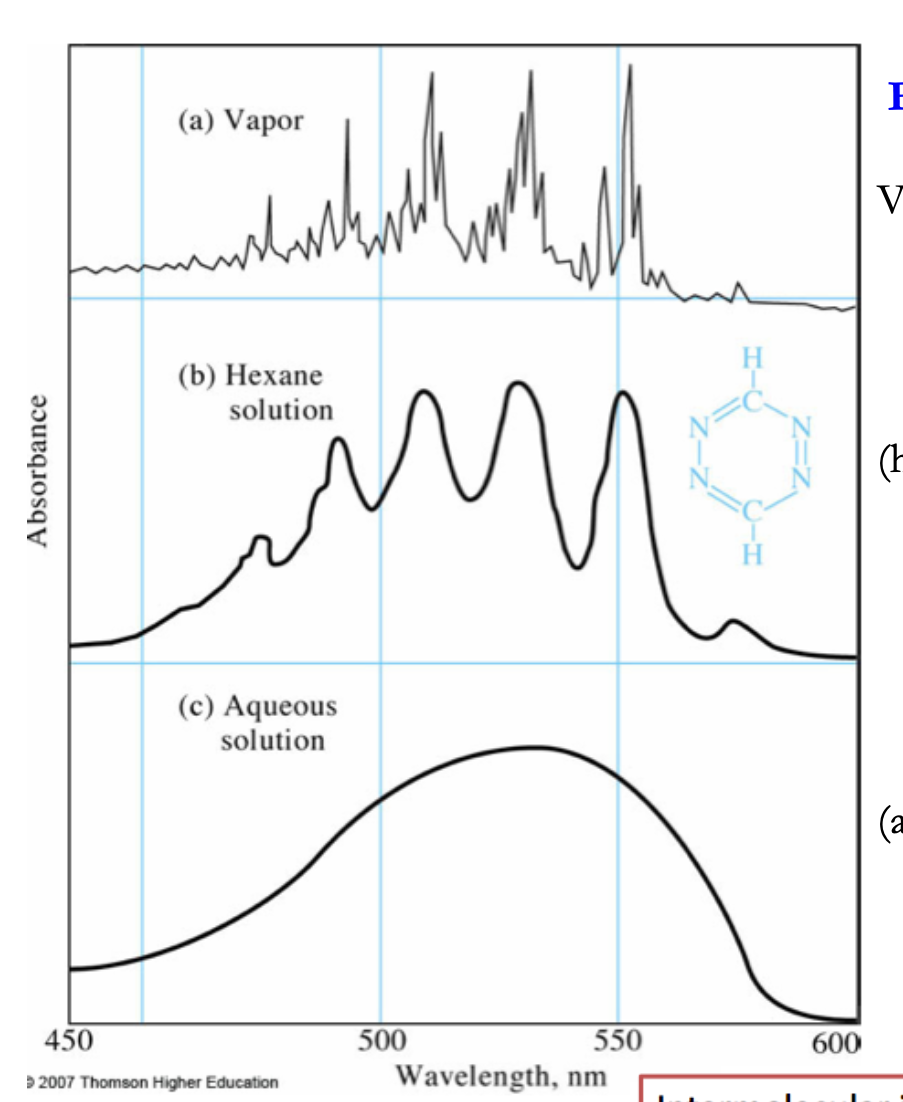
Molecular orbital
the non-localized fields b/t atoms that are occupied by bonding electrons (when two atom orbitals combine, either a low-energy bonding molecular orbital or a high energy anti bonding molecular orbital results)
Sigma Orbital
the molecular orbital associated with single bonds in organic compounds
Pi Orbital
the molecular orbital associated with parallel overlap of atomic P orbital
n electrons
no bonding electrons
MO theory to examine diatomic molecule H2
Subtractive combination - they subtract to get node, an anti bonding region
Addidtive combination - they add to get bonding region
End-on Interaction vs. In parallel interaction
UV/VIS electronic transitions
molecules have quantized energy levels
bonding orbitals are lower in energy than anti-bonding orbitals
non-bonding orbitals contains lone pair of electrons
as light absorbs electrons “jump” from bonding or non-bonding orbital to the anti-bonding orbitals
sigma* (normally empty)
Pi* (normally empty)
n(non-bonding)(contain lone pairs)
pi(bonding)(contain normal bonding pairs of electrons)
sigma(bonding)(contain normal bonding pairs of electrons)
3 types of transitions (arrange in terms of energy):
Excitation associated with single bond e- → vacuum UV (<185 nm) (difficult to access)
Most application of absorption spectroscopy → n→pi* or pi→pi* (200-700nm)(both require unsaturated functional group to provide pi orbitals - chromophores)
e for n→ pi* are usually low: 10-100 M^-1cm^-1
e for pi→pi* are usually higher: 1000-15000 M^-1cm^-1
sigma → sigma* TdeltaE large (lambda < 150 nm) e=10-10,000 L/mol*cm
n→sigma* (halogens, N,O,S) deltaE smaller (lambda = 150-250 nm) e=200-2000 L/mol*cm
pi→pi* n→pi* deltaE small (lambda = 200-700nm) e=10-10,000 L/mol*cm (ideal for UV-Vis spectrometry of organic chromophore)
(1 has the largest change in energy, 2 in middle, and 3 has smallest change in energy)
Typical UV Absorption Spectra
organic molecules: n→sigma* (e = 100-3000)
pi→pi* (e = 1000-10,000)
inorganic ions: transitions in the d electrons (non-bonding e-s)(low)
Charge-transfer complexes (typically large; e>10,000)
Absorption by saturated organic compounds- have low e(max)
Absorption of unsaturated organic compounds - have high e(max) ; transition type: pi→pi* (for alkene 13,000; for alkyne 10,000)
Unsaturated functional group →pi orbital
Effects of Multiple Chromophores
Olefin - lambda (max) - 184; e(max)=10,000
Diolefin (unconjugated) - lambda (max) -185; e(max) = 20,000
Diolefin (conjugated) - lambda (max) - 217; e(max) = 21,000
Spectral Shift
Red shift of lambda max w/ increasing conjugation (CH2=CHCH2CH2CH2CH2 (lambda (max) = 185 nm)
CH2=CHCH=CH2 (lambda (max)=217)
Red shift of lambda max with # of rings (benzene lambda max = 204 nm, Naphthalene lambda (max) - 286 nm
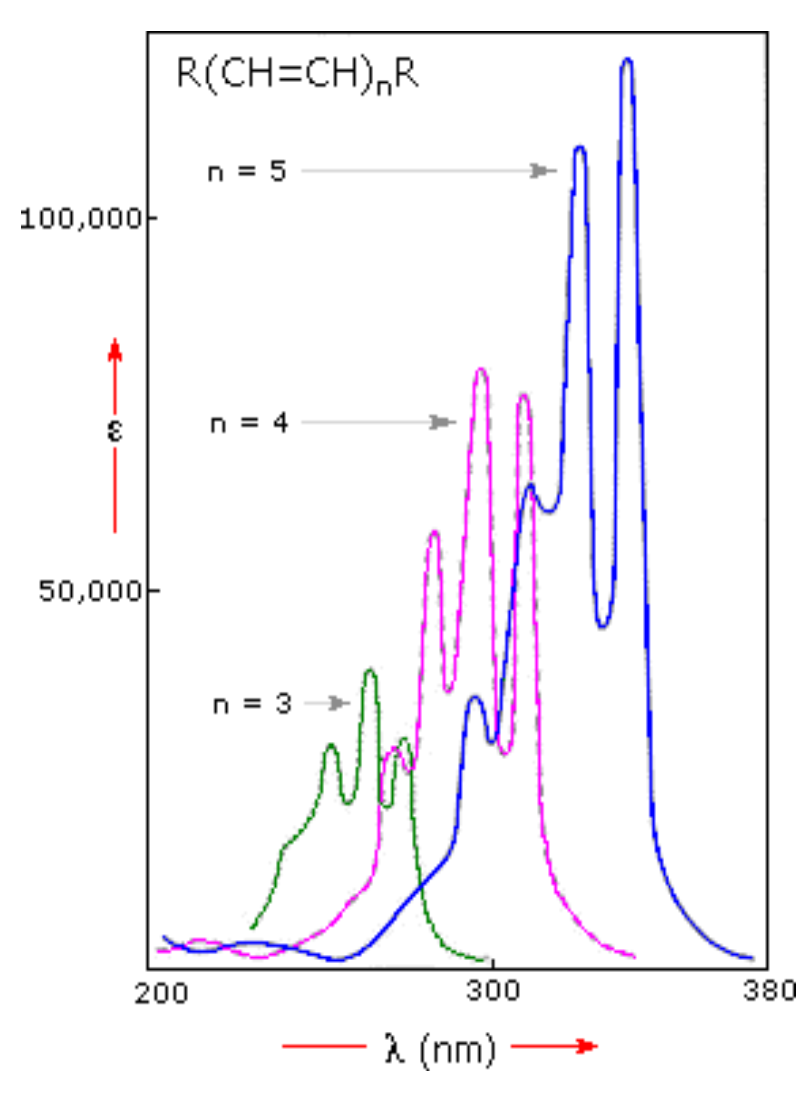
3 Electronic Transitions for organic molecules
sigma → sigma* transition in vacuum UV (single bonds)
n→sigma* saturated compounds with non-bonding e-s
- lambda = 150-250 nm; e=10-3000 (not strong)
n→pi*, pi→pi* requires unsaturated functional groups (e.g. double bonds, provide pi orbitals) most commonly used, energy good range for UV/Vis
- lambda about 200-700 nm
- n→pi* : e=10-100
pi→pi* : e =1000-10,000
Electronic Transitions for Inorganic compounds
common anions n→pi* nitrate (313 nm), carbonate (217 nm)
most transition-metal ions absorb in the UV/Vis region
for the first and second transition metal series, the absorption process results from transitions of 3d and 4d electrons(Ni2+,Cr2O72-,Cu2+,Co2+)
-the bands are often broad
-position of the maxima are strongly influenced by the chemical environment
-depend on its oxidation state, the nature of the ligand bonded to it
In the lanthanide and actinide series, the absorption process results from electronic transitions of 4f and 5f electrons(Ho3+,Er3+,Pr3+,Sm3+)
Charge-Transfer Absorption
A charge-transfer complex consists of an electron-donor group bonded to an electron acceptor. When this product absorbs radiation, an electron from donor is transferred to an orbital that is largely associated with the acceptor.
Large molar absorptivity (e(max)>10,000
Many organic and inorganic complexes
metal ions involved, organic compounds (Fe(SCN)2+, Fe(then)32+, Starch-I5-)
Qualitative Applications of UV-Vis Absorption Spectroscopy
Solvents Effect - they need to be transparent and do not erase the fine structure arising from the vibrational effects
-Polar solvents (heptane, water) tend to cause this problem, same solvent must be used when comparing absorption spectra for identification purpose.
Slit Width Effect - More narrower slit width (1 nm) →higher absorbance; More wider slit width (20 nm) → lower absorbance
Bathochromic Shift - the shift of absorption to a longer wavelength due to substitution or solvent effect ( a red shift)
Hypsochromic Shift - the shift of absorption to a shorter wavelength due to substitution or solvent effect (a blue shift)
Hyperchromic Effect - an increase in absorption intensity.
Hypochromic Effect.- a decrease in absorption intensity
Chromophore - a covalently unsaturated group responsible for electronic absorption (ex. C=C, C=O, NO2)
Autochrome - a saturated group with non bonded e-s that when attached to a chromophore, alters both the wavelength and intensity of absorption
Bathochromic Shift (red shift pi→pi*)
a change of medium - increasing polarity of solvent, then increase the attractive polarization forces b/t solvent and absorber, thus decreasing the energy of the unexcited and excited states with later greater.
substitution: an autochrome is attached to a C=C
Hypsochromic Shift (a blue shift n-pi*)
a change of medium - increasing polarity of solvent → better salvation of e- pairs (n level has lower E)
Ex. Acetone: lambda(max) of 279 nm (in hexane) is 264.5 nm (in water)
Substitution: an aux-chrome is attached to double bonds where n electrons are available (ex. C=O)
Hyperchromic Effect vs. Hypochromic Effect
Hyperchromic - leading to increased absorption intensity
Hypochromic - leading to decreased absorption intensity
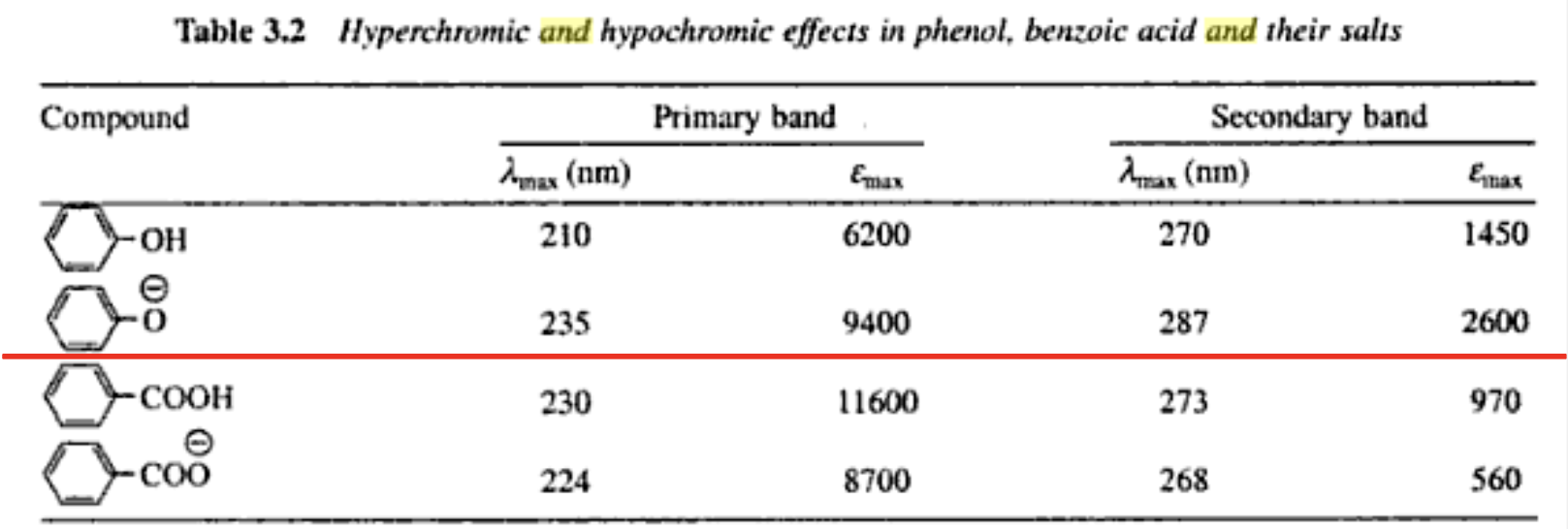
Absorption Shifts
Bathochromic - to longer wavelength
Hypsochromic - to shorter wavelength
Hyperchromic - to greater absorbance
Hypochromic - to lower absorbance
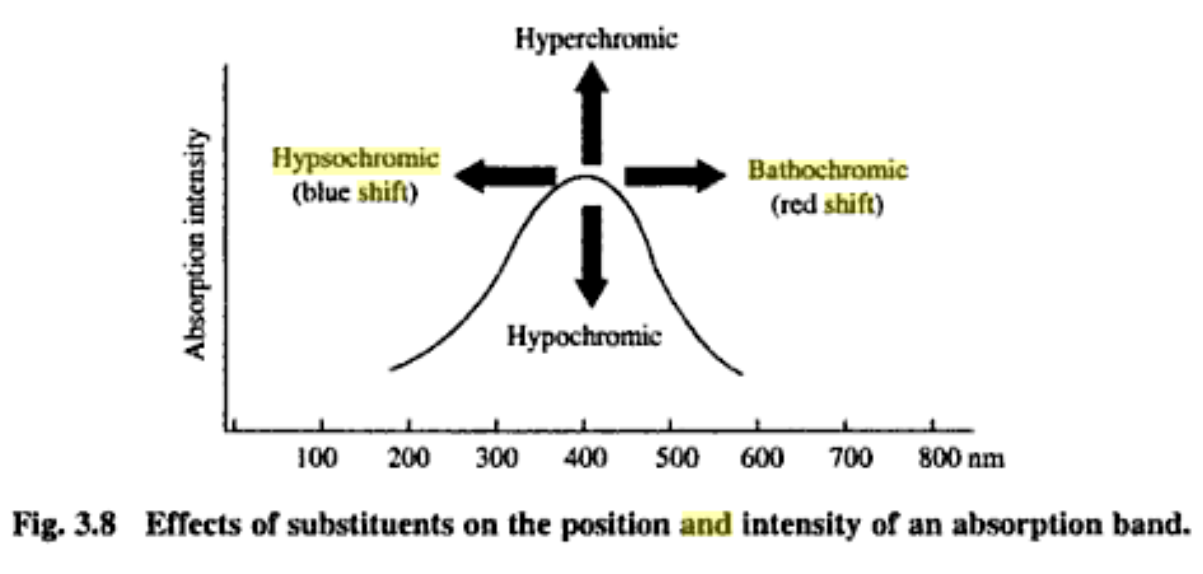
Quantitative Applications of UV-VIS Absorption Spectroscopy
Advantages:
wide applicability - organic and inorganic
low detection limit
high selectivity
good accuracy
ease and convenience of data process
Applications:
absorbing species
non-absorbing species (derivation)
relationship b/t A and C (standard additional method, analysis of mixtures)
Titrations
Complex ions (method of continuous variations, Mole-Ratio method)
Kinetic methods (stopped-flow kinetic)
Relationship b/t A and C (standard addition method)
very useful when sample is in a complex matrix
measurement done to sample+spiked sample
a standard-addition analysis using only two increments of sample
Cx = A1CsVs / (A2-A1)Vx
Solvig for a mixtures
both species (M and N) absorb differently
select two wavelengths
perform 4 calibration curves
calculate 4 absorptivity coefficients: eM1,eM2,eN1,eN2
measure absorbance at both wavelengths
A1 = eM1bCM + eN1bCN
A2 = eM2bCM + eN2bCN
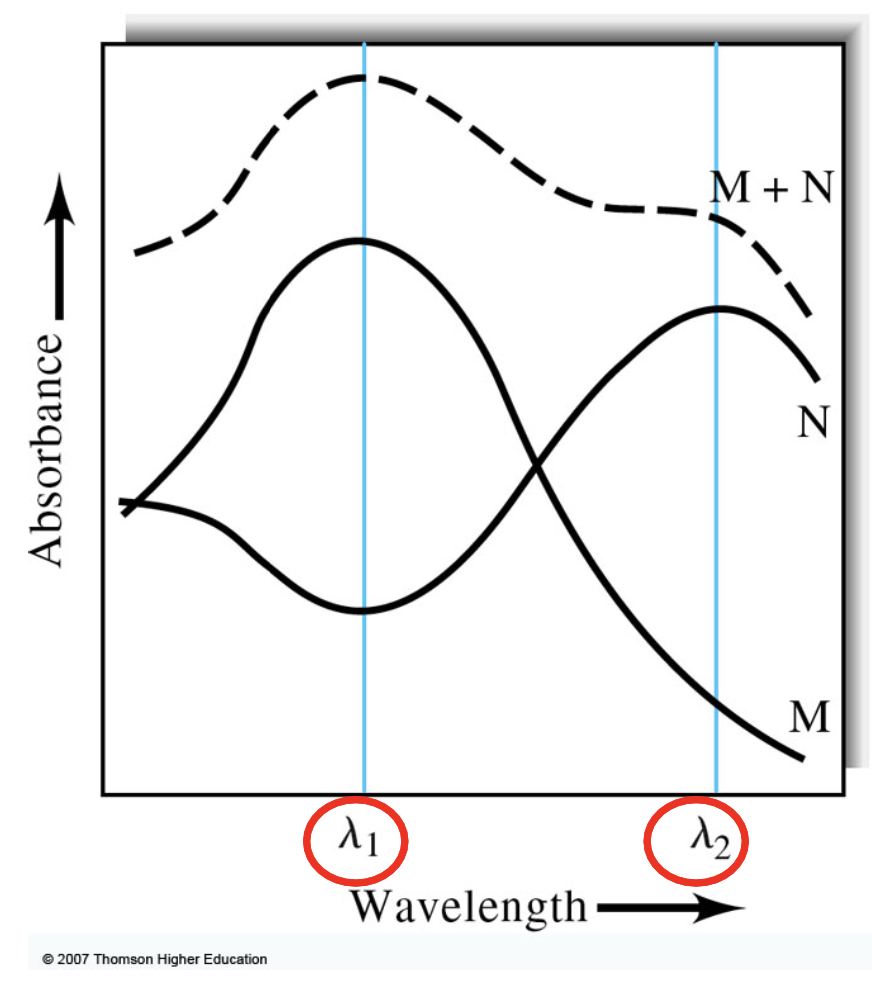
Titrations
Titration Curve
spectrophotometry used to determine the final point (source→filter→cell on magnetic stirrer→detector)
Photometric titrations:
a. colorless analyte and regent → colored product
b. colorless analyte and colored reagent → colorless product
c. colored analyte and colorless reagent → colorless product
d. colored analyte and reagent → colorless product
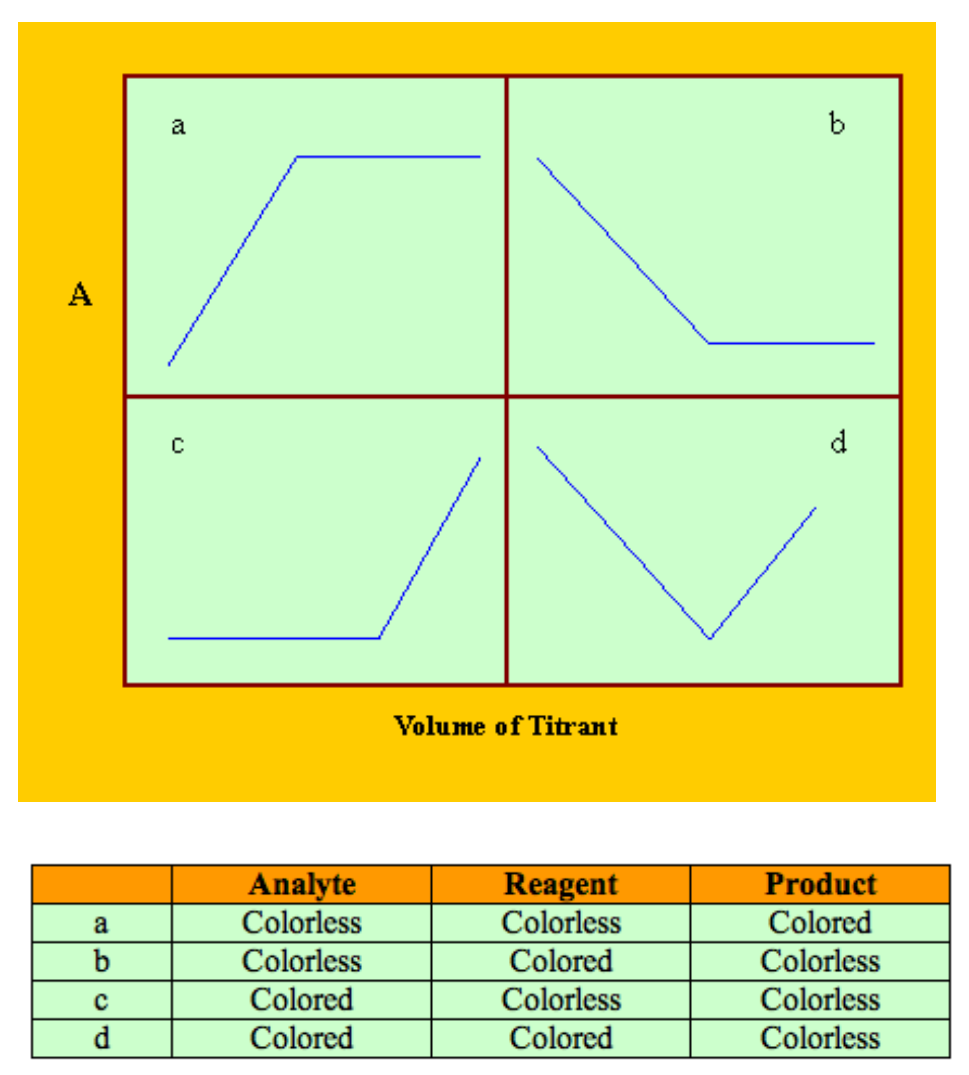
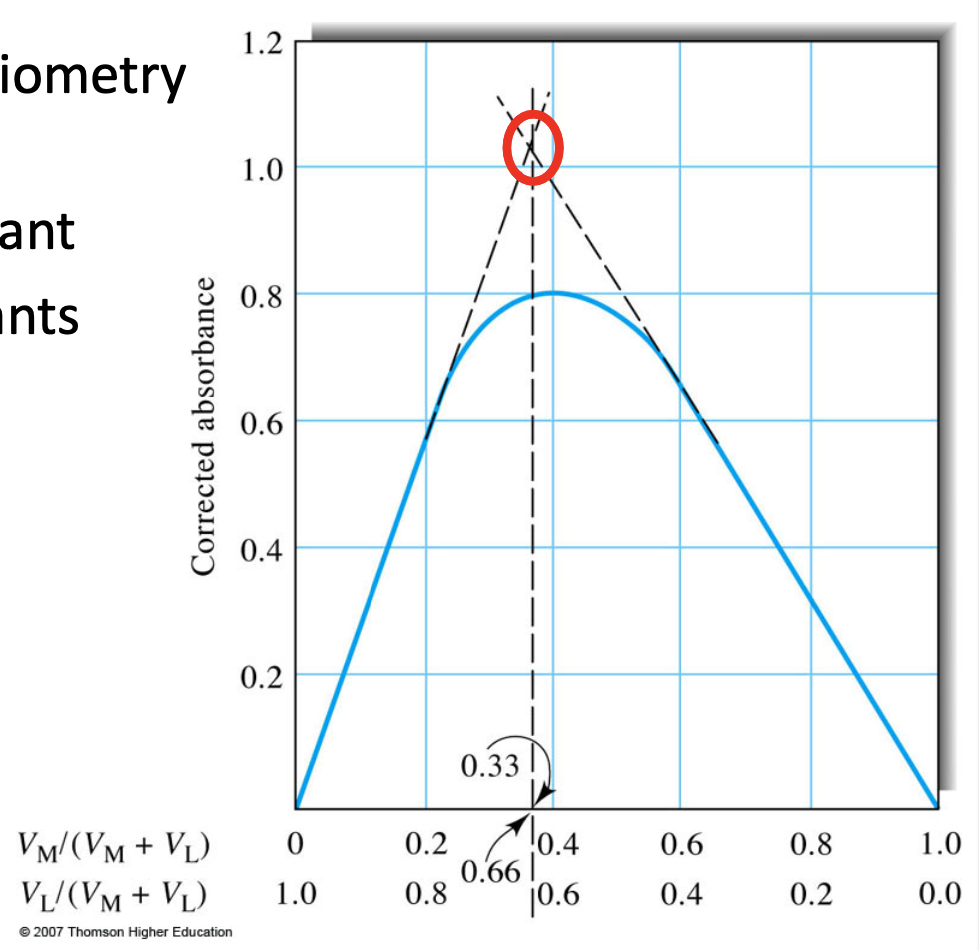
Complex Ions
Continuous-Various Method:
used to calculate stoichiometric ratios
Vtotal and Ntotal are constant
the mole ratio of reactants varies systematically
Mole-Ratio Method:
concentration of one reactant held constant, while other is varied
two straight lines of different slopes that intersect at a mole ratio corresponding to the combined ratio in the complex
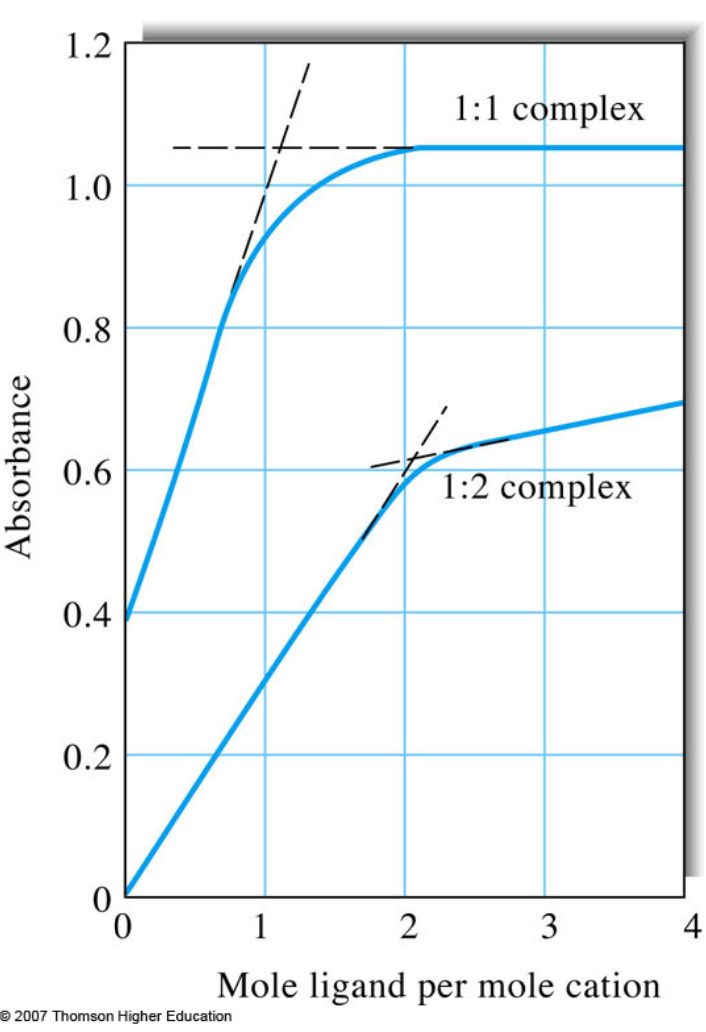
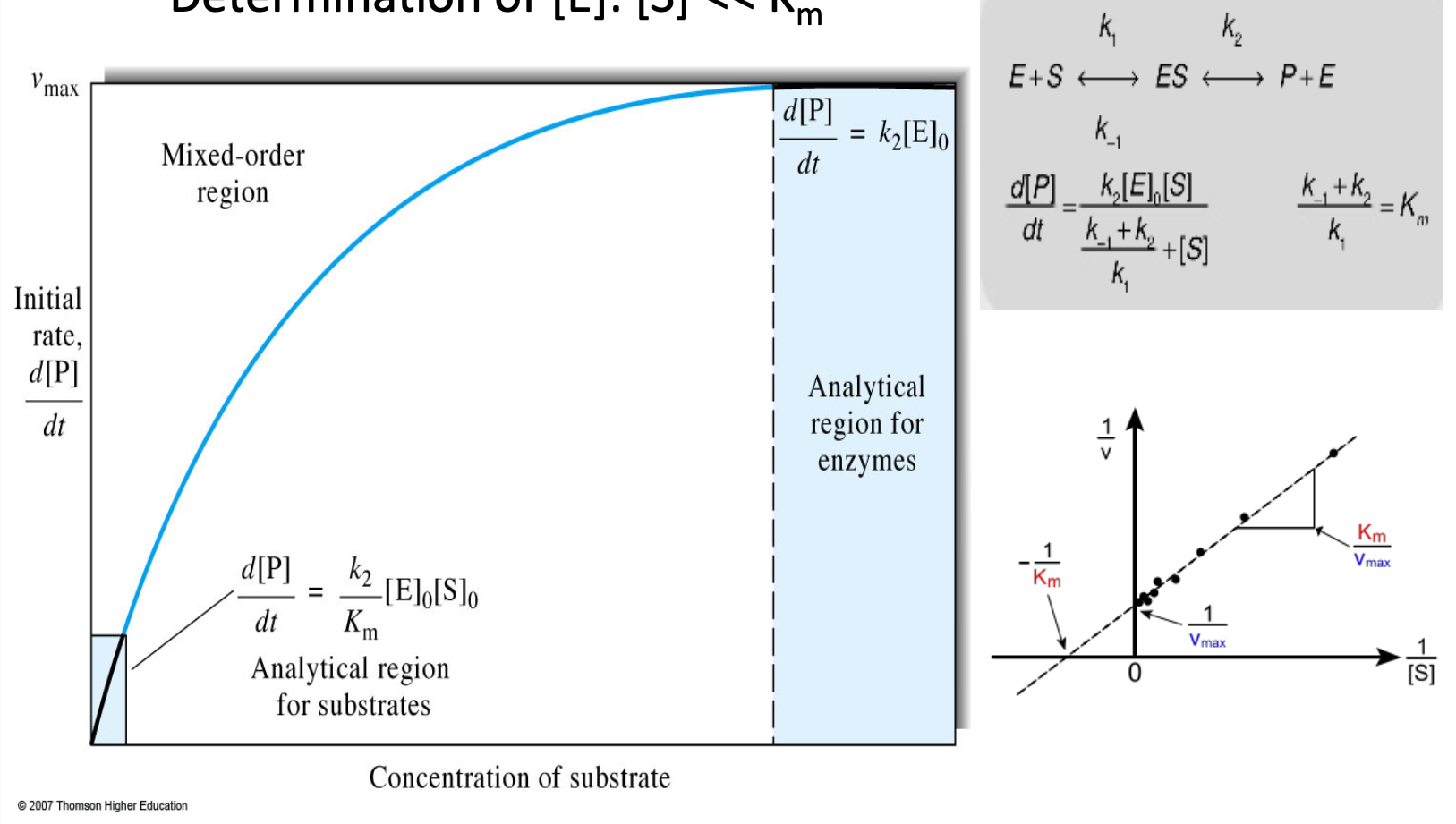
Kinetic Methods
Enzymatic reactions:
enzyme used to catalyze the rxns
determination of [E]:[S] » Km
determination of [E]:[S'] « Km
Kinetic monitoring techniques - stopped-flow:
a stopped-flow instrument can mix solutions in a couple of milliseconds and measure the dynamics of interacting proteins
Single vs. Double Mixing Stopped-Flow
A (yellow) +2B (light blue) →3C (red) (+9.67, +0.05)